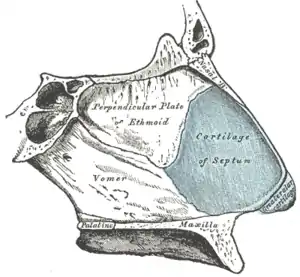Kiesselbach's plexus
Kiesselbach's plexus, is a vascular network of the five arteries that supply the nasal septum. The arteries anastomose to form the plexus which is a common site for nosebleeds. It lies in the anterior inferior part of the septum known as Little's area, also Kiesselbach's area, or Kiesselbach's triangle. The arteries are:[1]
- Anterior ethmoidal artery (branch of the ophthalmic artery)
- Sphenopalatine artery (terminal branch of the maxillary artery)
- Greater palatine artery (from the maxillary artery)
- Septal branch of the superior labial artery (from the facial artery)
- Posterior ethmoidal artery (branch of the ophthalmic artery) - There is contention as whether this is truly part of kiesselbach's plexus. Most sources quote that it is not part of the plexus but rather one of the blood supplies for the nasal septum itself.

It runs vertically downwards just behind the columella, crosses the floor of the nose and joins venous plexus on the lateral nasal wall. It is a common site for bleeding in young people.[2]
Clinical significance
Ninety percent of nosebleeds (epistaxis) occur in Kiesselbach's plexus, as it is exposed to the drying effect of inspiratory currents and to finger nail trauma and is the usual site for nosebleeds in children and young adults.[3][4]
History
James Lawrence Little (1836–1885), an American surgeon, first described the area in detail in 1879. Little described the area as being "about half an inch ... from the lower edge of the middle of the column [septum]".[5]
Kiesselbach's plexus is named after Wilhelm Kiesselbach (1839–1902), a German otolaryngologist who published a paper on the area in 1884.
See also
References
- Moore, Keith L. et al. (2014) Clinically Oriented Anatomy, 7th Ed, p.959
- Dhingra. Diseases of Ear,Nose and Throat. Elsevier.
- Doyle, DE (Mar 1986). "Anterior epistaxis: a new nasal tampon for fast, effective control". The Laryngoscope. 96 (3): 279–81. doi:10.1288/00005537-198603000-00008. PMID 3951304.
- Nasal Anatomy at eMedicine
- Little, James Lawrence (1879). "A hitherto undescribed lesion as a cause of epistaxis, with four cases". The Hospital Gazette. New York. 6 (1): 5–6.
External links
- Epistaxis - utmb.edu
- Nose Anatomy - emedicine.com
- Nasal Anatomy - fpnotebook.com